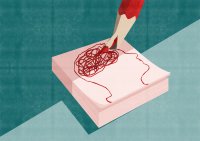3 Ways to Reduce Stress and Build Connections During Distance Learning
Remote learning will likely play a role in students’ lives once schools reopen. Here’s how teachers and parents can help kids manage stress, build resilience, and stay connected.
Your content has been saved!
Go to My Saved Content.As the pandemic grinds on and protests against police brutality and systemic racism continue, young people are coping with high levels of stress and uncertainty, writes Dr. Pamela Cantor in “The Stress of This Moment Might Be Hurting Kids’ Development” for Education Next. With the likelihood that remote learning will continue in some form this fall, many children will once more be separated from the support systems that help balance their lives by keeping them connected to routines—and to the people outside their immediate families who care about them. It’s a difficult set of circumstances that Cantor, founder and senior science advisor of Turnaround for Children, calls “the Covid-19 paradox.”
“In order to be safe and keep others safe from the virus, we must be physically distant. But that means disrupting the communities and relationships in our lives—classrooms, teachers, teams, coaches, churches, friends, extended families—that are the very connections we need to feel safe, to cope with stress, and to surmount this crisis,” writes Cantor. “On top of this, there is a crisis of trust, particularly for young people of color, because of what they are witnessing: Officers who should protect them, but don’t, won’t, or can’t.”
When people experience stress, the hormone cortisol is released in the body, producing the fight, flight, or freeze impulse. Some stress may be useful in preparing kids for challenging tasks like tests and performances. “This is the limbic system in the brain at work—attention, concentration, focus, memory, preparation,” writes Cantor. But persistently high levels of stress can become toxic, affecting attention and memory. The hormone oxytocin, however, can help protect children from these harmful effects. “Relationships that are strong and positive cause oxytocin’s release, which helps produce feelings of trust, love, attachment, and safety,” Cantor writes. “This not only helps children manage stress, but also offsets the damaging effects of cortisol and produces resilience to future stress.”
As students head back to school this fall with the possibility of hybrid learning models and rolling school closures, educators and parents will play an important role in helping to “inoculate us against the intolerable stress of the scary, uncertain world we now live in,” she writes. Cantor suggests adults focus on a new take on the “Three Rs”: relationships, routines, and resilience.
Relationships: When students are learning from home, teachers can maintain relationships by connecting through virtual advisory groups and individual online meetings. Cantor recommends a strategy called two-by-ten: A teacher makes a specific goal of talking one-on-one with a struggling student for two minutes for a 10-day stretch. These quick, focused interactions can build relationships and provide emotional boosts that may produce oxytocin.
To reinforce connections with families, teachers can check in with them regularly via video chat. If needed, a set of predetermined questions can help educators gain insight into how students and families are coping with issues like homework, organization, and keeping up with the daily routine of online classes.
Another way to encourage caregivers and kids to stay connected at home—Cantor calls them “oxytocin boosters”—is by suggesting they pursue activities together, like cooking a family dinner as a unit or calling a grandparent. One New York teacher even organized “Tasty Tuesdays” during which her 2nd grade students share breakfast via Zoom.
Routines: Our brains, writes Cantor, are “prediction machines that like order, and when our environments are orderly, the brain is calmer.” To establish predictable routines at home, families can create weekly schedules that include time alloted for academics, unstructured time for playing or working on projects, and even regular family meetings. Schools can support families by encouraging routines like healthy family meals, daily exercise, and mindfulness practices such as deep breathing and journaling.
During distance learning, teachers can create fun activities that address both emotional and academic needs and map to the students’ schedules. For example, a second-grade teacher “dresses up in superhero costumes to read students bedtime stories that include vocabulary and comprehension lessons,” Cantor writes.
Once schools reopen, “the primary focus should be physical, emotional, and identity safety”—the necessary precursors to academic work—writes Cantor. Teachers can continue to establish routines in the classroom with lists and sticky notes.
Resilience: Built over time, the skill of resilience “begins with learning how to regulate emotions and behaviors from role models through a process called co-regulation,” Cantor says. During remote learning, teachers can foster resilience by reminding students that we all “need to manage ourselves and our fears every single day,” and families can help by encouraging teamwork and creative problem-solving, celebrating successes, and modeling healthy strategies for managing anxiety and stress. Guiding kids so they develop the ability to recognize their emotions and strengthen their resilience during distance learning will help prepare them for the return to physical school in the new year.
When kids do return to the classroom, educators should strive to create a “safe, supportive environment; strong, developmental relationships; and integrated and rigorous academic, skill, and mindset development,” Cantor concludes. When these elements are prioritized, they provide an “ecological vaccine, rich in protective factors that ignite the developing brain, promote wellness, and protect children from the damaging effects of stress.”
